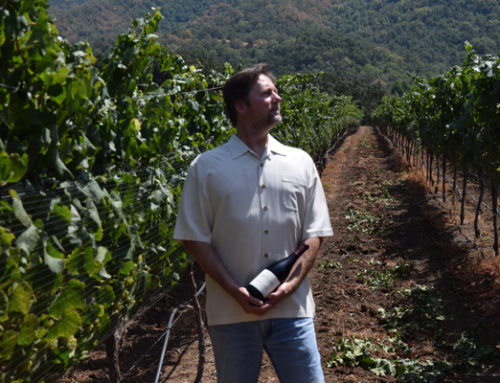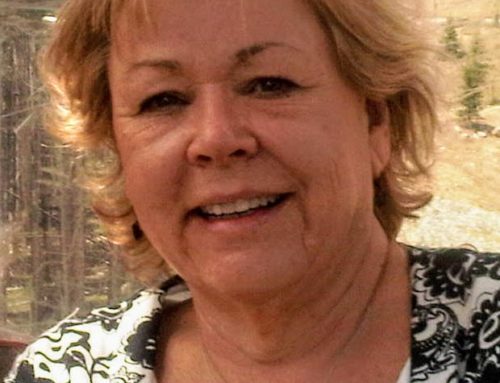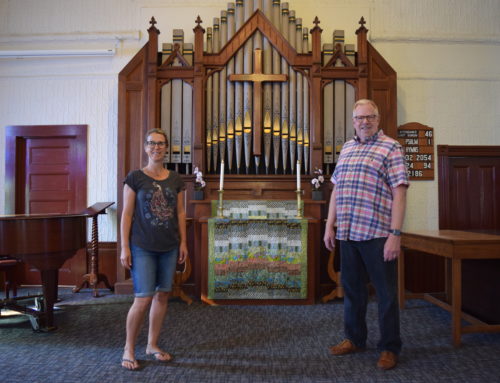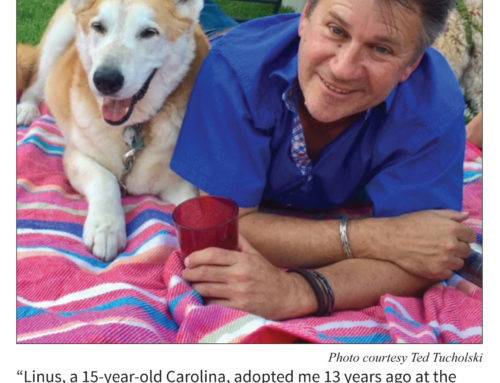Commission OKs revised recommendation that eliminates neighborhood access points to trail
Published in the September 17-30, 2014 issue of Morgan Hill Life
By Robert Airoldi

Above: Stu Nuttall on the lawn at City Hall with El Toro Mountain in the background.
Photo by Marty Cheek
Round one goes to the neighbors living at the base of El Toro Mountain. Before a packed crowd Sept. 4, the Morgan Hill Parks and Recreation Commission went against city staff and revised a recommendation that would have created three trail access points at the ends of Main Avenue, Via Grande Drive, Alkire Avenue and at West Dunne Avenue.
Instead, the commission unanimously agreed that a lone access point on land yet to be purchased or leased by the Open Space Authority from West Hills Community Church near DeWitt Avenue was a good compromise to satisfy hikers and neighbors. The OSA owns the land on the mountain near the church’s upper parking lot.
The PRC’s recommendation is expected to go to the City Council in either November or December, and council members will ultimately decide whether or not to include the neighborhood access points.
Amy Whalen, a Via Grande resident for the past 10 years, said safety was a concern as there are at least four families on her street with small children, including her own.
“I’m pleased with the commission’s revised recommendation,” she said. “If access to the hill is inevitable and there’s an opportunity for access to be in a place with a public parking lot, that seems reasonable.”
The number of people hiking through her neighborhood has grown in the past 10 years, she said.
“It’s disconcerting having strangers in your front yard.”
And the prospect of strangers roaming through the neighborhoods at the base of El Toro wasn’t the only concern expressed at the special PRC meeting. Trash, vandalism, increased traffic, the degradation of the natural flora and fauna and fires, were cited as concerns as well.
Long history
El Toro Mountain is perhaps the most visible landmark in the city, with its silhouette marking the city’s logo. People climb the 1,077-foot prominence now, but they do so illegally, passing no tresspassing signs and climbing over gate barriers to get to the peak. In 1989, the city purchased a 42-acre parcel to preserve the land as open space, allow public access and to prevent development.

Photo courtesy Morgan Hill Historical Society
El Toro Mountain, also known as Murphy’s Peak, sits in the background of this historical photo of the early days village of Morgan Hill.
The OSA’s recent purchase of a hillside parcel on the southwest flank of the mountain was done with the intention to expand open space and to provide a trail connection to the trail system on El Toro, which was included in the Trails and Natural Resources Study.
The trail system is consistent with the OSA’s detailed report intended to guide the agency during the next three decades. Four years ago, the city council approved the purchase of an 18-acre hillside parcel, known as the Acton property, to further continue the city and the OSA’s vision. As a part of that purchase, a trail access easement was acquired at the west end of Via Grande Drive.
Since 2008, the Morgan Hill Historical Society and Boy Scouts conducted an organized public hike up the mountain every spring. Each year, from 800 to 900 people climbed the mountain to gain access to the top and enjoy a panoramic view of Morgan Hill and the South Valley. However, due to increased contention over property rights, no public hikes to the summit have been permitted since 2011.
In 2012, the Morgan Hill Parks and Recreation Commission re-initiated a study started a decade earlier to create a public trail to the summit.
Many concerns
Susan Bernardini, a 46-year resident who was part of a group that saved El Toro mountain from development years ago when the idea of a hotel, restaurant and tram up the mountain was proposed, said this is the same thing.
“It’s no different,” she said at the Sept. 4 meeting. “What about us? We saved El Toro. I really ask you to study the safety issues.”
Joe McMorrow, a resident on Via Grande for six years, said he first heard of the plan to open the mountain from his neighbors when he moved to Morgan Hill. He said keeping the landmark untouched, ensuring it stays pristine, is his goal.
“We’re happy that there is a solution for the city so they can get access,” he said. “I get it, people love to climb that mountain, but there are still concerns.”
A study a year or so ago by the city showed that 70 people hiked the hill one random Saturday; 25 on a weekday. McMorrow expects those numbers to dwindle some, but trespassers will continue trekking up El Toro.
“Maybe not inviting people to our neighborhood we’ll see the numbers go down, but I’d rather see the city back off completely,” he said.
Andrea Mackenzie, general manager for the OSA disagreed with most speakers at the PRC meeting. She said the land was purchased by the city and the OSA with the intent of allowing the public to enjoy it and share it.
“What’s being proposed here is an improvement over anything that we could have in the future,” she said. “We’ll work with the community to ensure that comes to fruition.”
Stu and Debbie Nuttall are in favor of opening the trail to as many people as possible. They don’t live on the base of the mountain but enjoy hiking.
“Access should be authorized, monitored and safe. Open it up and see how undesirable it becomes to renegade visitors,” she told PRC members.
Her husband Stu said the reality is people hike up the mountain every day.
“No matter what we do they’ll go up that hill,” he said. “What’s being proposed is a more safe alternative.” He agrees with eliminating the neighborhood access points, “but to try and wall that mountain off is just not going to work.”
A manager at the Campbell Sports Basement store, he sees the potential for a safe public access trail on El Toro to promote exercise and fitness for Morgan Hill residents and to eliminate the trail scar on the east face of the mountain caused by decades of illegal hiking activities.
“We support outdoor activities,” he said. “That trail is inevitable, whether we make it legal or we don’t. As long as people want to climb that mountain, that scar is going to be there and the erosion is going to continue.”
Contrary to what some speakers at the PRC meeting said, Stu does not believe a public access trail will bring significant numbers of hikers from other parts of Santa Clara County to hike El Toro.
“It’s a local attraction,” he said. “It’s not a county attraction. It’s not a San Jose attraction.”
Compromise found
The city’s strategy was to identify access points that make the trails available to as many people as possible while not overly burdening any particular neighborhood. The proposed trailhead on the church’s property on DeWitt south of Spring Avenue would include a parking lot, information kiosk and restrooms, according to Mackenzie. Police and fire officials both told PRC members that there is no statistical data that shows public trails increase crime or the chance of fire.
After hearing all the comments from the public, staff and the public, Commissioner LaRene Green said after reading the staff report, she believed that multiple access points was a good call.
“But after listening to all the comments, I’ve kind of changed my opinion to thinking that one access point is a better plan,” she said. “I know multiple access points would allow a loop.”
Commissioner Mary Seehafer proposed a compromise that would eliminate the neighborhood access points and agreed there’s not a lot of parking room for additional traffic flow of hikers seeking to climb El Toro and that having just one access point at DeWitt is best, if possible. She also asked staff if it was possible to find a way to connect the trail from the south along the base of the mountain but away from the neighborhoods, thus creating a loop.
Doug Muirhead, a southwest Morgan Hill resident for nine years, said he was pleased with the commission’s recommendation of a single access point a few blocks south from the various neighborhood streets.
“I’ve been waiting for a couple of years to move past the discussion stage,” Muirhead said. “It was a good compromise. Staff bent over backwards in working with the neighbors to alleviate their concerns. Now people who want to legally use the trails get to use the trails.”







